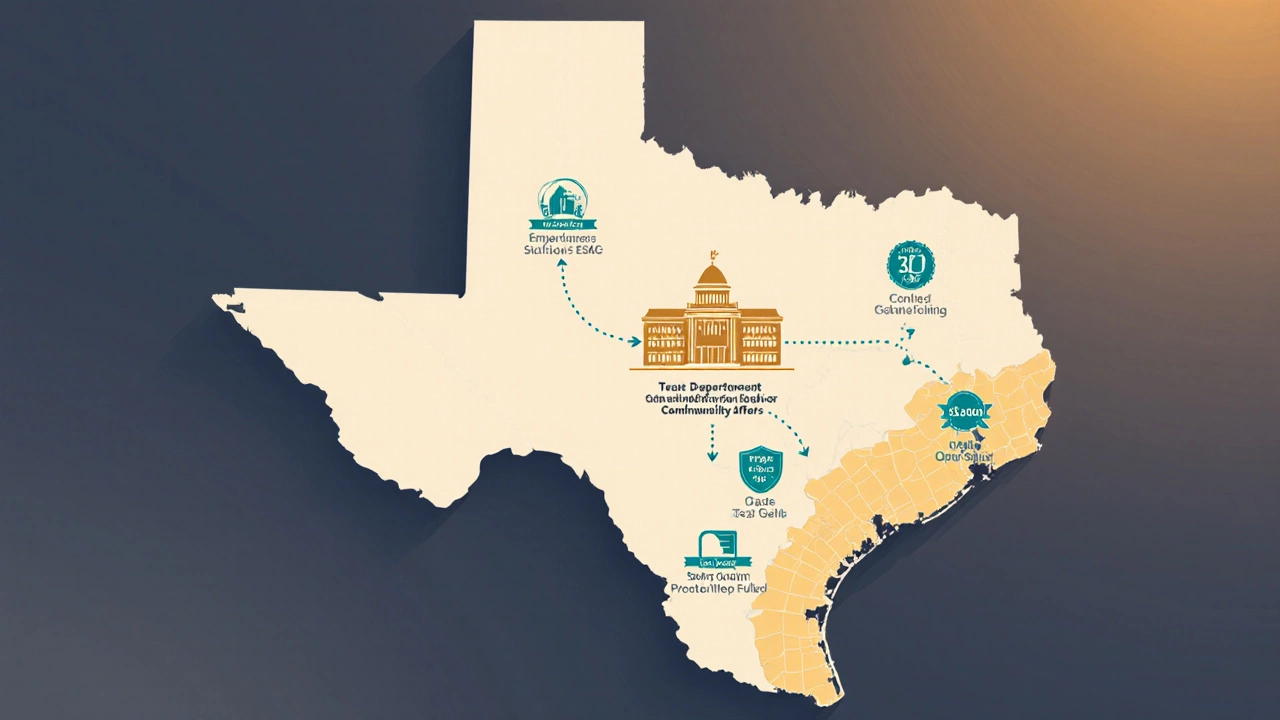Texas Homeless Services Comparison Tool
Compare Homeless Services Across Texas Cities
See funding amounts, emergency bed capacity, and service providers in major Texas cities
How to Use This Tool
Select one or more cities from the dropdown to see how they compare in terms of:
- Annual funding for homeless services
- Emergency shelter bed capacity
- Lead service providers
Texas Homeless Assistance Programs are a network of state‑run and partnered initiatives that provide emergency shelter, transitional housing, and supportive services to people experiencing homelessness across the Lone Star State. Understanding how these programs work helps residents, advocates, and policymakers see where help is available and where gaps remain.
State‑Level Funding Overview
The Texas legislature allocates roughly $600million each fiscal year to address homelessness. Most of this money flows through the Texas Department of Housing and Community Affairs (TDHCA), the primary agency that administers federal grants and state‑specific funds.
Key funding streams include:
- Emergency Solutions Grant (ESG) - a federal program that supports emergency shelters, homelessness outreach, and rapid rehousing.
- Continuum of Care (CoC) Program - provides formula‑based funding for agencies that meet national CoC standards.
- State Homelessness Prevention Fund - earmarked for rapid rehousing and prevention services.
These funds are distributed to local service providers based on demonstrated need, performance metrics, and compliance with reporting requirements such as the Homeless Management Information System (HMIS).
Major Programs and Their Roles
Below are the most influential programs that make up the Texas homeless assistance landscape.
- Emergency Solutions Grant (ESG): Offers short‑term shelter and rapid rehousing. In 2024, ESG funded over 12,000 families statewide.
- Continuum of Care (CoC): Provides long‑term funding for coordinated entry systems, transitional housing, and case management. Texas has 33 CoC regions, each led by a local coalition.
- Homeless Management Information System (HMIS): A data platform that tracks client demographics, service usage, and outcomes. Accurate HMIS reporting is required to receive ongoing funding.
- Texas Coalition for the Homeless: A statewide advocacy group that lobbies for increased funding and policy reforms.
- Lone Star Foundation: A private charitable organization that supplements public funds with grants for emergency shelters and employment programs.
City‑Level Initiatives
Major metros run their own supplemental programs that complement state funding.
- Austin Shelter Network: Operates 15 emergency shelters, a daily outreach team, and a rapid rehousing pilot that has placed over 500 families since 2022.
- Houston Homeless Services: Manages the Houston Continuum of Care, which coordinates over 200 service providers and runs the city’s largest homeless encampment clean‑up effort.
- Dallas Community Services: Runs a “Housing First” initiative that provides permanent supportive housing without pre‑conditions, funded largely by the ESG and private donors.
These city programs often receive additional municipal funds, allowing them to address local nuances such as climate‑related shelter needs and regional labor market conditions.

How Funding Is Distributed
Funding follows a multi‑step pipeline:
- State legislature approves the annual budget for homelessness services.
- The Texas Department of Housing and Community Affairs (TDHCA) allocates federal ESG and CoC grants to regional coalitions.
- Local coalitions submit proposals that outline how they will meet performance metrics like reduced street homelessness and increased housing placements.
- Agencies use HMIS to report outcomes quarterly. Consistent data quality ensures continued funding.
Performance‑based funding means agencies that demonstrate higher placement rates and better client outcomes receive larger future allocations.
Challenges and Gaps
Despite the sizeable budget, several obstacles limit effectiveness:
- Housing affordability: Rapid rehousing often stalls because affordable units are scarce, especially in high‑cost cities like Austin.
- Data integration: Some counties still rely on manual entry for HMIS, leading to reporting delays.
- Rural outreach: Vast rural areas have fewer shelters, and transportation barriers keep many residents from accessing services.
- Funding volatility: Economic downturns can trigger budget cuts, jeopardizing long‑term projects.
Addressing these gaps requires coordinated policy changes, increased private sector partnerships, and innovative housing solutions such as tiny‑home villages.
How Residents Can Get Help
If you-or someone you know-needs assistance, follow these steps:
- Locate the nearest emergency shelter using the HUD shelter directory (search by ZIP code).
- Contact the local Continuum of Care office. They can conduct a rapid entry assessment and connect you to housing resources.
- Apply for the State Homelessness Prevention Fund if you’re at risk of losing housing. Eligibility typically includes income below 50% of the area median.
- If you have a disability, request integrated services through the Texas Department of Aging and Disability Services (DADS), which can provide case management.
- Consider short‑term employment programs offered by the Lone Star Foundation, which often partner with shelters to help residents gain income quickly.
Keeping copies of identification, proof of income, and any medical documentation speeds up the intake process.

Quick Checklist for Navigating Texas Homeless Services
- Know your ZIP code and nearest shelter.
- Call the local Continuum of Care (CoC) office.
- Gather ID, income statements, and medical records.
- Ask about rapid rehousing eligibility.
- Explore private‑sector programs (e.g., Lone Star Foundation grants).
Funding Comparison by City (2024)
| City | Funding (USDMillions) | Emergency Beds | Main Managing Agency |
|---|---|---|---|
| Austin | 120 | 3,800 | Austin Shelter Network |
| Houston | 210 | 5,200 | Houston Homeless Services |
| Dallas | 150 | 4,500 | Dallas Community Services |
| San Antonio | 95 | 2,900 | San Antonio Homeless Coalition |
Frequently Asked Questions
What is the primary state agency that handles homeless assistance in Texas?
The Texas Department of Housing and Community Affairs (TDHCA) administers most federal and state homelessness grants, including ESG and CoC funds.
How can I find an emergency shelter near me?
Use the HUD shelter directory or call the local Continuum of Care office with your ZIP code; they can provide the closest shelter address and intake hours.
Does Texas provide funding for rapid rehousing?
Yes. Both the Emergency Solutions Grant and the State Homelessness Prevention Fund allocate money for rapid rehousing, allowing families to move directly into affordable rental units.
Are there special programs for veterans?
Veterans can access the VA’s Homeless Programs, which are coordinated with state agencies through the Texas Veterans Homeless Assistance Program.
What data system tracks homelessness services in Texas?
The Homeless Management Information System (HMIS) collects client data, service usage, and outcome metrics for all funded providers.
